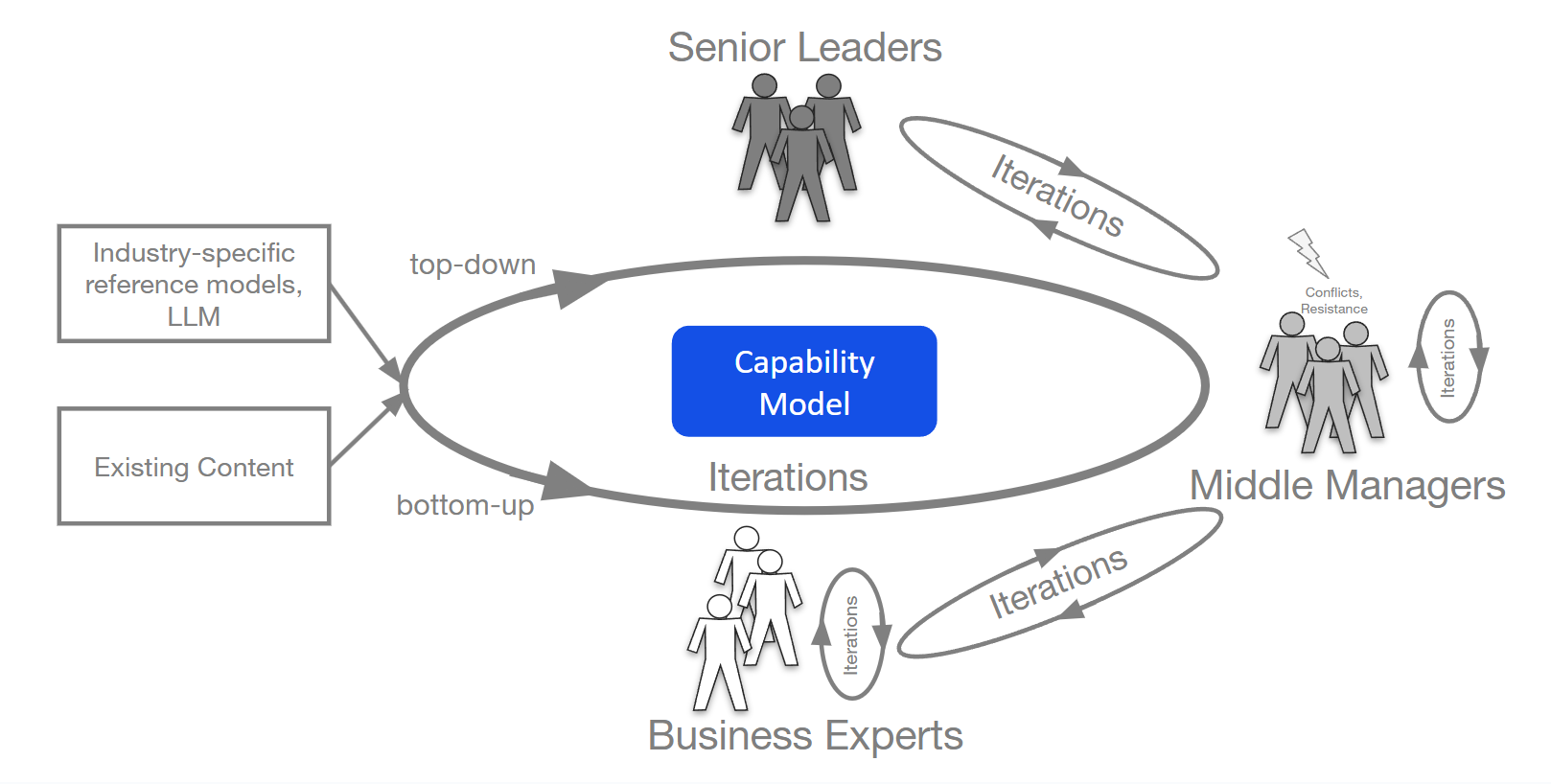Capability Modelling Guidelines | How to use Capabilities to Align Investments with Purpose
Co-create through top-down and bottom-up iteration
By exploring industry reference models and existing content, you have gained a basic understanding of the enterprise, created a first draft of a Capability Map, and identified many open questions. Now it is time to discuss these questions and work with business experts and leaders to develop the Capability Map further. This collaboration will help clarify your understanding and improve the initial draft, moving toward a shared understanding among your co-creators. This ensures that later discussions about performance and investment take into account all critical aspects of the Enterprise, from high-level strategy to detailed operational execution.
Finding common ground can be challenging. Different viewpoints, interests, and priorities often lead to disagreements. Keep in mind: the goal is not to create a perfect Capability Map, but to establish a process that builds alignment. Creating the map together with all relevant co-creators always reveals conflicts and forces people to resolve them in the best interest of the entire enterprise. Iterations, as illustrated in the diagram below, are crucial for developing a Capability Map that is both accurate and widely supported.
When running an iterative capability modelling process, you can start either from the top of the organisational hierarchy and work downwards to capture details, or you can begin with the business expert level and work up to the boardroom. Both approaches have their pros and cons:
Top-down
Top-down is often helpful when you need a quick, big-picture view to make significant decisions rapidly. In this scenario, senior leaders scaffold a high-level capability model (typically at the capability group level) and delegate validation and elaboration of specific capabilities to middle managers and business experts. All co-creators iterate to create a coherent capability model.
Pros:
- Engages senior leaders early.
- Faster iterative [[process]: start top-down, then elaborate at lower levels.
- Suitable for top-down management cultures.
- Facilitates recruitment of all participants required to create and assess capability performance.
- Accelerates decision-making.
- Makes it easier to capture the overall structure of the map before filling in details.
- Modelling time is likely shorter if senior leaders sponsor the initiative, even without direct involvement in the details.
Cons:
- Less creative; teams tend to focus on the current state.
- Risk of missing essential details.
- Senior leaders may align the capability model too closely with the organisational chart.
- Higher risk of getting lost in the details.
Bottom-up
Bottom-up works best when you do not have a mandate from senior leaders and must start your Enterprise Design initiative at lower levels of the organisation. It is beneficial when facing an adaptive challenge (e.g., a strategy shift or significant transformation) where solutions are not predetermined and the team must mobilise resources across the organisation.
The process typically starts with the existing vision statement. A team of business experts covering all parts of the business scaffolds the model (Levels 1–3). Level 3 capabilities are grouped into Level 2s and Level 1s. The co-creation team then iterates a representative view of the future state.
Pros:
- Increases buy-in from all relevant business experts.
- Supports accurate decision-making and diverse perspectives.
- Suits more autonomous management cultures.
- Encourages creativity and forward-looking thinking.
- Builds alignment and reinforces ownership: It’s OUR Enterprise.
- Creates a coalition for change.
- Identifies new, concrete capabilities needed for the future.
Cons:
- Slower; requires substantial effort to run interviews, distil insights, and synthesise findings.
- Requires multiple levels of approval up the chain.
- Risk of losing sight of strategic direction and management priorities.
- Danger of focusing too much on the how rather than the what.
- May produce many individual ideas that do not align with the vision or future state.
Practical tips
Take your time and involve a broad range of business experts.
Enterprises are complex. Gaining an understanding of what’s actually going on and how people understand the capabilities takes time and numerous interviews.
- Small Enterprises (<500 employees): 3-6 months, 10-20 people,
- Large Enterprises: 12-18 months, 20-50 people.
Deal with the emotional side of change.
Capability modelling brings clarity to the changes the enterprise wants to make. Change inevitably means that some people may have less influence and often experience fear and resistance. The most challenging aspect of co-creating a Capability Map is learning to collaborate with others who are going through these difficult emotions.
Train your empathy, listening, and trust-building skills to be ready for this challenge.
Related Patterns
- #3: Coalition Building
- #5: Co-Created Enterprise Design Charter
- #7: Safe Negotiation Space
- #12: Human Interest
- #13: Nurtured Trust
- #14: Powerful Questions
- #15: Listening to Understand
- #16: Hint
- #17: Tangible Presence
- #18: Walking Your Talk
- #30: Depicting Shared Understanding
| ← Previous page | Next page → |
